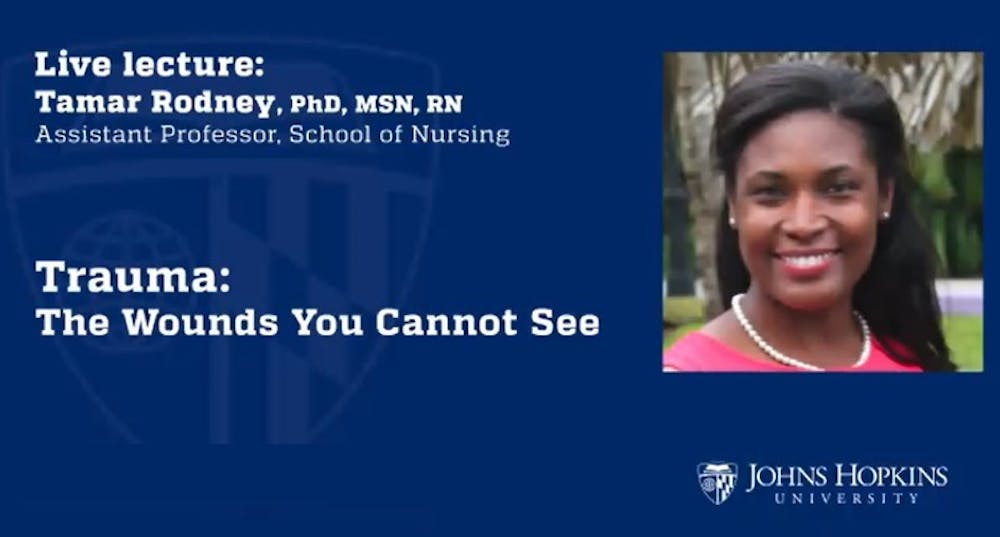Tamar Rodney, an assistant professor at the School of Nursing, discussed post-traumatic stress disorder (PTSD) during the pandemic in her lecture “Trauma — The Wounds You Cannot See” on April 6.
Rodney, whose research focuses primarily on improving PTSD diagnosis and treatment, opened the lecture by describing the evolution of trauma. She explained that trauma is induced by a repeated or one-time event that evokes a memory which may be positive, negative or a mix of the two.
Rodney defined diagnosable PTSD as someone with “a history of trauma exposure involving actual or threatened death or serious injury to oneself or others.” Although PTSD is often associated with those who have experienced or seen physical injury, Rodney believes that PTSD may also be experienced after emotionally traumatic events. She believes that even for those of us who have not been diagnosed with COVID-19, the pandemic is likely a source of emotional trauma.
Rodney presented two models that attempt to capture how an individual experiences trauma. The diathesis–stress model assumes that every person is born with a predisposition to coping with traumatic life events. These genetic factors in combination with external environmental stressors determine an individual’s traumatic outcomes.
The second model is called the Roy Adaptation Model. In this model, different physiological or physical traumatic stimuli lend to a coping process of the body and the mind which in turn results in different outcome behaviors.
However, according to Rodney, neither of these models will likely capture the trauma induced by the pandemic, since the pandemic involved a series of events instead of one single traumatic event.
“There’s sacrifices that are being made on a day-to-day level that can be just as traumatic and comparable to the virus itself,” Rodney said. “The last 12 months have been a recurring series of traumatic events.”
Rodney described two other unique features of the pandemic that differentiate it from other traumatic events: loneliness and the uncertainty of the pandemic.
According to Rodney, there are six different “lenses of trauma” through which we can view an individual’s experience of the pandemic: the age of the individual, the amount of time spent in the pandemic, protective factors, continuum levels, reactionary levels and variable experience.
While the age of an individual is easily attainable, as of now, how much time we will spend in the pandemic is unknown. Protective factors, such as having more than one companion during quarantine, can improve one’s overall experience. Continuum refers to the levels of anxiety that the individual may have felt. Reactionary levels measure the preparedness of the individual to cope with the pandemic. Lastly, variable experience refers to each individual’s personal reactions to the pandemic due to different innate predispositions.
“With these lenses that we look at trauma, there is no clean stroke brush to deciding what will be, which is part of what makes it so difficult to treat, to diagnose and to accept,” Rodney said.
There are four clusters of symptoms associated with PTSD: intrusion, avoidance, negative mood and hyperarousal. Intrusion includes intrusive thoughts, flashbacks and recurrent nightmares. Avoidance includes actively avoiding activities, situations or places that are reminders of the traumatic event. Negative mood can mean an inability to recall aspects of the traumatic event, loss of interest in other activities or detachment. Hyperarousal can refer to difficulty sleeping, being easily startled and irritability.
“Many of these behaviors can be done in silence on an individual level and it is very likely that no one will ever know, or they might see one but they won’t see the range of behaviors that an individual is experiencing,” Rodney said.
A person’s lifetime risk for experiencing a traumatic event and subsequently developing PTSD is 8.7%. Rodney believes that prevalence will be much higher at least for the next year due to the pandemic. According to Rodney, symptoms of PTSD can be delayed from months to years and can result in a loss in family connection and jobs, as well as instances of domestic violence.
For those who may be experiencing PTSD from the pandemic or any other traumatic events, Rodney suggested four coping strategies: taking some time off to recover; limiting caffeine and alcohol intake; making an effort to validate your feelings; and trying to accept that there are some things in life that you cannot change.
Rodney also strongly encourages us to reach out and support others who may be dealing with PTSD.
“We are 12 months in, but we are not sure how far this is going to go,” she said. “We need to be gentle and kind to ourselves as we process different elements of trauma, and to others, extend a ton of kindness whenever we can because it might make all the difference.”





